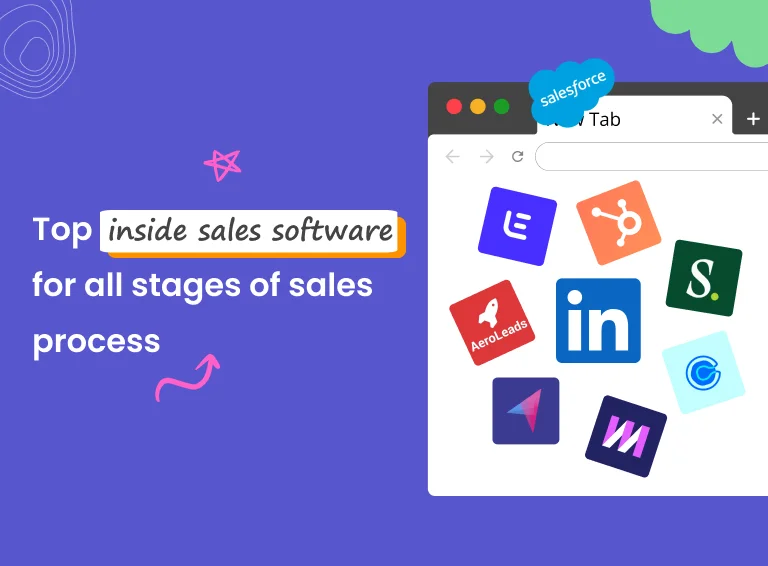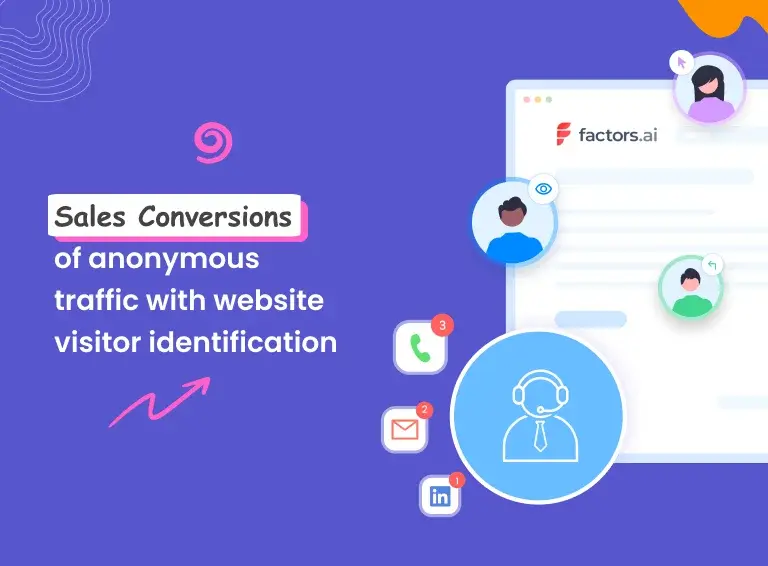Sales development representatives (SDRs) seem to have their hands full at all times.
Each of them carries out around a zillion activities every day, like making 50 calls, sending a whole lot of emails, and social and custom steps. They’re constantly moving from one lead to another, handling objections and building relationships with minimal downtime in between.
Amidst this hectic schedule, it could be hard to take a step back and look at productivity. In fact, 79% of sales leaders believe that increasing the productivity of the existing sales reps in their organization is a key driver of meeting new targets.
The best SDRs organize their tasks for the day, focus on their top priorities, avoid distractions, and are constantly looking for ways to increase their productivity. Here, we bring you the top 9 tips that are backed by science and views of sales experts that you can adopt to 3x your productivity.
9 Tips To Improve SDR Productivity
1. Have a Morning Routine That Starts From the Previous Night

As the saying goes, well begun is half done. For sales reps, who tend to have a busy day ahead of them when they get out of bed every day, having a fixed morning routine will help you enter the workplace in a better mood to face the day’s challenges.
The best way to go about your morning routine is to begin from the previous night before you hit the bed. Create a to-do list containing the most important tasks for the next day, lay out essentials like your keys and any important papers for the morning.
Avoid checking your phone in bed first thing in the morning, as research shows that coming across something negative right after you wake up will trigger your stress response and might leave you feeling unsettled throughout your work day, thereby impacting your productivity. Make sure to include exercising as part of your morning routine, as a study shows how just 10 minutes of aerobic exercise can decrease your negative mood state and fatigue and increase vigor.
Being optimistic and excited as a salesperson is especially important as prospects mirror your energy, and that’s crucial in booking meetings.
2. Invest Your Time in Mindfulness Exercises

With so many tasks on hand, it’s quite easy for SDRs to get exhausted. To prevent this, mindfulness exercises will be helpful.
Mindfulness is a state of being fully aware of what we’re doing and where we are by focusing our attention on the present moment without letting external distractions overwhelm us. A study reveals how mindfulness programs enhance the overall well-being of an employee by decreasing employee stress and improving resiliency, vigor, and work engagement.
In particular, this is useful for SDRs because being mindful can help you remain calm and composed during difficult situations like overcoming objections and facing rejections. This helps in moving on to the next tasks quicker, thereby improving your productivity.
Before starting your work and during breaks, block 2-5 minutes and just focus on your breath by suspending active thinking and any kind of judgment. You may also use apps like Headspace or Insight Timer on your phone if needed.
3. Double Down on Your Prospecting Efforts

One of the most important high-impact works of an SDR is prospecting. However, a study that analyzed 116 million sales activities found that sales reps spend a staggering 99.5% of their time on bad accounts (companies) that do not convert.
Hence, by focusing on good accounts, your chances of booking meetings go up substantially, which boosts your productivity.
Good sales prospecting starts with having a well-enriched list of high-quality prospects. Don’t just reach out to anybody –even those that resemble the ideal customer profile(ICP) on paper, may actually not be. Spend time doing the homework–that’s researching whether each prospect matches the ICP. Look up people’s LinkedIn, their company’s profiles, and their information on Zoominfo or other data intelligence tools to check if people match your ICP and then add them to your potential customer list. While doing this, also ensure you get all of their data accurately. Enterprise-level prospects do not take lightly getting their names wrong.
Among the existing prospects, evaluate those that engage with your communication and focus on those who can bring in maximum revenue to the sales team. Sort all the bad prospects and colder leads to the least priority list, and keep them as a backup list.
4. Time Blocking

Time blocking is a method of time management that asks you to break up your day into segments or blocks. Each block should contain one or more tasks—and no other assignments will be completed during that segment of time.
Use the time-tested Pomodoro technique to block hours of your work day and focus on completing a set of tasks with maximum concentration.
Instead of keeping an ever-growing list of tasks whose completion is always uncertain, you’ll define a concrete schedule that specifies what work needs to be done and when.
Parkinson's Law states that "work expands so as to fill the time available for its completion." In other words, if you have more time to spend on your project than you originally thought, you will over-commit and end up spending more hours than you had planned.
The same applies to sales development reps: if you have more time to spend on their prospecting efforts than you originally planned.
With the right habits, you can make sure your time is spent at the top of your sales funnel.
Here's how to use this simple strategy to make sure you're getting the most out of every hour of work.
- First thing in the morning: check prospecting emails & replying to emails,
- Then: execute all tasks in your sales engagement platform or CRM -- (like follow up with prospects on LinkedIn, email, calls...etc.)
- Then: do research for personalization etc.
- Next: revisit current emails/follow-up emails, and check the quality of the email content/format etc.
- In addition to time blocking, consider using a time tracking app to understand how much time each task takes.
5. Be Proactive, Not Reactive

Reactive salespeople sit in their inboxes and wait for their prospects to reply to their emails. Proactive salespeople are out there building relationships, getting referrals, and engaging with their prospects. No points for guessing who is the most productive here.
Some things that you can do to be a proactive SDR include researching more about the prospects, personalizing cold emails, and following up with vigor. There’s a quote made famous by salespeople for salespeople, “Always be prospecting.” If you think your pipeline is full, think again. Keep prospecting whenever you can, and flush your pipeline with fresh prospects regularly.
In phone conversations especially, being proactive plays a big role in turning the tides in your favor. When talking to prospects, don’t ball up in a defensive position, open up and ask questions, and don’t take no for an answer, just yet.
On one hand, there’s the quota that stresses you out, and on the other, there’s objections. While setting quotas is outside this blog’s purview, we can tell you how to effectively handle objections. Just be proactive. List down possible objections before running your calls–whether you’re a beginner or an expert–predict what may be the prospect’s inhibitions, and find out how you can face it.
6. Optimize Your Call Scripts and Sales Emails Every Week or Month

Top sales development reps often revisit their cold email and follow-up email templates, and call scripts, quite regularly too. Because prospects can feel fatigued by a certain email or call strategy, and certain kinds of subject lines. You’ll need to revisit your templates, A/B test different email strategies to get replies. Don’t rely on call scripts all the time, focus on just building rapport instead of reading off a script.
Here are some follow-up email templates you can use to run your A/B tests.
Here’re some email strategies you can try using:
- Personalize your subject line by leaning into a pain point
- Personalize the opening line with information from LinkedIn.
- Use the prospect’s fresh Twitter or other social media activity in the intro.
- Break the fourth wall (Let them know that you are aware that they are aware that this is the 4th or 5th or whichever follow-up it is.)
- Tell them how you’ve helped other companies solve problems that are similar to theirs (Use case studies, testimonials)
- Tell them that they might run into a problem soon if nothing's done (Use the latest industry/research report)
- Give them a link to an online/downloadable resource (that belongs to your company or others) to help them solve a problem. (Use e-books, industry/research reports, blogs, podcasts, videos, and social media posts from industry experts)
7. Time-Zone Correction in the CRM

Most SDRs are assigned certain geographies to work with. That means you’re calling different people in different time zones. You wouldn’t want to cold call somebody at 1 a.m. now, do you?
To avoid annoying your prospects at the wrong time and to make more successful calls, add time zone data to qualified leads in your CRM so that when you schedule the calls, you can set them to suit their timings.
8. Automate Your Sales Engagement Process

A sales engagement software helps you deliver high-quality, personalized interactions with prospects at scale. By automating the repetitive functions of your sales process like running hundreds of outreach campaigns, multichannel engagement, and analyzing engagement metrics, a sales engagement platform helps you focus on meaningful engagement with prospects like building relationships, finding solutions, managing sales pipeline effectively, and closing deals.
Today, having sales engagement software is essential if you’re a high-functioning, fast-growing organization.
With it, sales managers and salespeople alike no longer have to work from their gut feeling and pray their strategies bear fruit; instead, they can make even the most minute decisions based on data-driven insights churned out by the software. For example: Run two outreach campaigns with two sets of email sequences and find out which one’s better engaged. And choose the better email sequence for all your prospects to enjoy higher engagement rates.
How does using a sales engagement software improve your productivity?
- Enjoy consistent results with a centralized sales process
- Have richer interactions with prospects by personalizing at scale
- Reach prospects wherever they are with multichannel outreach
- Time-saving automation: Get more work done in less time
- Coach your SDR team effectively to close deals faster
- Review real-time email engagement metrics to improve outreach
9. Run Effective Discovery Calls

A discovery call in SaaS is your best chance at finding out how serious the buyer is if they’re looking for something specific, and how you could turn the sale in your favor and shorten your sales cycle. Never go into a discovery call with no battle plan, especially in B2B sales.
An effective discovery call can be broken down into three parts:
- Rapport building - Focus on easing the prospect into the call, making them comfortable enough to open up with you.
- Discovery deep dive - Ask the right questions. Dig out information about the prospect, their team, their company, their processes, and their workflows.
- Closing - Focus on a clear action plan for the prospect to reduce their cognitive load.
If you’ve got the questions ready and have prepared different options for the prospect, you are all sorted.
Bottomline
For SDRs, productivity is the make-or-break essential considering the sometimes chaotic and unpredictable nature of their job. So, if you want to be a top performer, block times, start meditating, and optimize your current workflows. Create these habits, and follow them religiously — it’ll shape your performance for the better.
Frequently Asked Questions
How long does it take an SDR to make 100 cold calls?
So, now you’d spend only 2-3 minutes per call, in which case, you could make 100 hundred calls in 3-4 hours. Ideally you could block two hours in the day and another two hours in the evening and power through.





